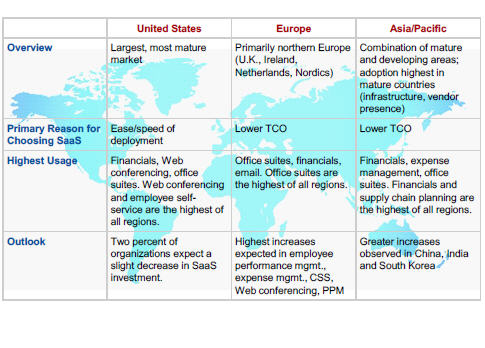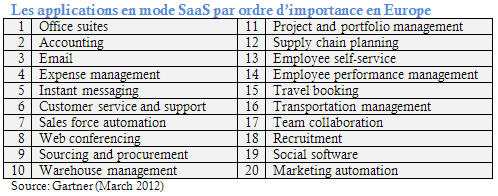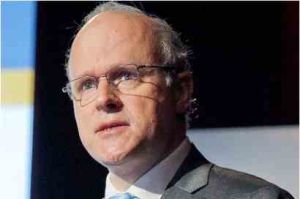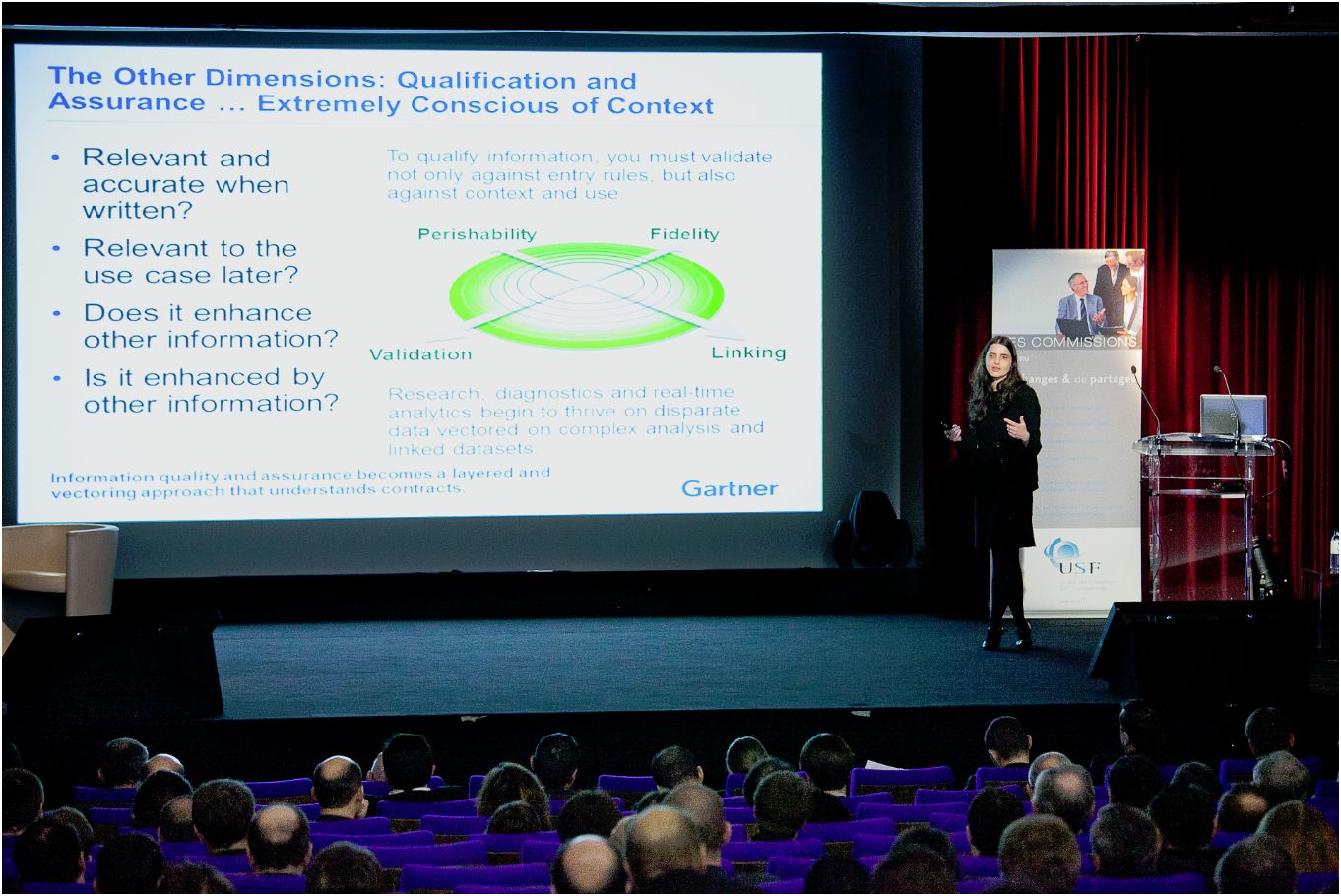A lire sur: http://www.gartner.com/it/page.jsp?id=1940715&M=b5f2c65c-0c65-45a9-bbe3-4d6c710704af
Special Report Shows Hybrid IT Challenges
Longstanding Practices of IT Organizations and Business Models of
Traditional IT Vendors
STAMFORD, Conn.,
March 5,
2012—
Hybrid IT is transforming IT
architectures and the role of IT itself, according to Gartner, Inc.
Hybrid IT is the result of combining internal and external services,
usually from a combination of internal and public clouds, in support of a
business outcome.
In the Gartner Special Report, "Hybrid IT: How Internal and External Cloud Services are Transforming IT" (http://www.gartner.com/technology/research/technical-professionals/hybrid-cloud.jsp), analysts explained that hybrid IT relies on new technologies to connect clouds, sophisticated approaches to data classification and identity, and service-oriented architecture, and heralds significant change for IT practitioners.
"Many organizations have now passed the definitional stage of cloud computing and are testing cloud architectures inside and outside the enterprise and over time, the cloud will simply become one of the ways that we 'do' computing, and workloads will move around in hybrid internal/external IT environments," said Chris Howard, managing vice president at Gartner. "As a result, the traditional role of the enterprise IT professional is changing and becoming multifaceted. A hybrid IT model requires internal and external IT professionals to support the business capabilities of the enterprise."
Cloud computing's business model — the ability to rapidly provision IT services without large capital expenditures — is appealing to budget-minded executives. CEOs and CIOs are pressuring IT organizations to lower overhead by offloading services to cloud providers. However, when IT organizations investigate potential cloud services, the market's volatility reveals that not all cloud services are created equal.
"IT organizations are taking an 'adopt and go' strategy to satisfy internal customer IT consumerization and democratization requirements," Mr. Howard said. "Many IT organizations are adopting public cloud computing for noncritical IT services such as development and test applications, or for turnkey software as a service (SaaS) applications such as Web analytics and CRM that can holistically replace internal applications and enable access for a mobile workforce."
For critical applications and data, IT organizations have not adopted public cloud computing as quickly. Many IT organizations discover that public cloud service providers (CSPs) cannot meet the security requirements, integrate with enterprise management, or guarantee availability necessary to host critical applications. Therefore, organizations continue to own and operate internal IT services that house critical applications and data.
However, the public cloud has affected internal customers. Because of the pervasive growth of public clouds, many business units and internal customers have used and grown accustomed to IT as a service and have built business processes and budget plans with cloud computing in mind. Now these internal customers are demanding that IT organizations build internal private clouds that not only house critical applications, but also provide a self-service, quickly provisioned, showback-based IT consumption model.
"IT organizations that do not match the request for IT as a service run the risk of internal customers bypassing the IT organization and consuming IT services from the external cloud, thereby placing the company at greater risk," said Mr. Howard. "IT organizations realize that they not only need to compete with the public cloud consumption model, but also must serve as the intermediary between their internal customers and all IT services — whether internal or external."
IT organizations are becoming the broker to a set of IT services that are hosted partially internally and partially externally — hybrid IT architecture. By being the intermediary of IT services, IT organizations can offer internal customers the price, capacity and speed of provisioning of the external cloud while maintaining the security and governance the company requires, and reducing IT service costs.
This model of service delivery challenges both the longstanding practices of IT organizations and the business models of traditional IT vendors. Gartner expects that most organizations will maintain a core set of primary service providers (cloud and noncloud) extended by an ecosystem of edge providers who fulfill specific solution requirements.
"Hybrid IT is the new IT and it is here to stay. While the cloud market matures, IT organizations must adopt a hybrid IT strategy that not only builds internal clouds to house critical IT services and compete with public CSPs, but also utilizes the external cloud to house noncritical IT services and data, augment internal capacity, and increase IT agility," said Mr. Howard. "Hybrid IT creates symmetry between internal and external IT services that will force an IT and business paradigm shift for years to come."
Additional information is available in the Gartner Special Report "Hybrid IT: How Internal and External Cloud Services are Transforming IT" at http://www.gartner.com/technology/research/technical-professionals/hybrid-cloud.jsp. The Special Report includes video commentary of more than a dozen reports examining the various elements of Hybrid IT.
In the Gartner Special Report, "Hybrid IT: How Internal and External Cloud Services are Transforming IT" (http://www.gartner.com/technology/research/technical-professionals/hybrid-cloud.jsp), analysts explained that hybrid IT relies on new technologies to connect clouds, sophisticated approaches to data classification and identity, and service-oriented architecture, and heralds significant change for IT practitioners.
"Many organizations have now passed the definitional stage of cloud computing and are testing cloud architectures inside and outside the enterprise and over time, the cloud will simply become one of the ways that we 'do' computing, and workloads will move around in hybrid internal/external IT environments," said Chris Howard, managing vice president at Gartner. "As a result, the traditional role of the enterprise IT professional is changing and becoming multifaceted. A hybrid IT model requires internal and external IT professionals to support the business capabilities of the enterprise."
Cloud computing's business model — the ability to rapidly provision IT services without large capital expenditures — is appealing to budget-minded executives. CEOs and CIOs are pressuring IT organizations to lower overhead by offloading services to cloud providers. However, when IT organizations investigate potential cloud services, the market's volatility reveals that not all cloud services are created equal.
"IT organizations are taking an 'adopt and go' strategy to satisfy internal customer IT consumerization and democratization requirements," Mr. Howard said. "Many IT organizations are adopting public cloud computing for noncritical IT services such as development and test applications, or for turnkey software as a service (SaaS) applications such as Web analytics and CRM that can holistically replace internal applications and enable access for a mobile workforce."
For critical applications and data, IT organizations have not adopted public cloud computing as quickly. Many IT organizations discover that public cloud service providers (CSPs) cannot meet the security requirements, integrate with enterprise management, or guarantee availability necessary to host critical applications. Therefore, organizations continue to own and operate internal IT services that house critical applications and data.
However, the public cloud has affected internal customers. Because of the pervasive growth of public clouds, many business units and internal customers have used and grown accustomed to IT as a service and have built business processes and budget plans with cloud computing in mind. Now these internal customers are demanding that IT organizations build internal private clouds that not only house critical applications, but also provide a self-service, quickly provisioned, showback-based IT consumption model.
"IT organizations that do not match the request for IT as a service run the risk of internal customers bypassing the IT organization and consuming IT services from the external cloud, thereby placing the company at greater risk," said Mr. Howard. "IT organizations realize that they not only need to compete with the public cloud consumption model, but also must serve as the intermediary between their internal customers and all IT services — whether internal or external."
IT organizations are becoming the broker to a set of IT services that are hosted partially internally and partially externally — hybrid IT architecture. By being the intermediary of IT services, IT organizations can offer internal customers the price, capacity and speed of provisioning of the external cloud while maintaining the security and governance the company requires, and reducing IT service costs.
This model of service delivery challenges both the longstanding practices of IT organizations and the business models of traditional IT vendors. Gartner expects that most organizations will maintain a core set of primary service providers (cloud and noncloud) extended by an ecosystem of edge providers who fulfill specific solution requirements.
"Hybrid IT is the new IT and it is here to stay. While the cloud market matures, IT organizations must adopt a hybrid IT strategy that not only builds internal clouds to house critical IT services and compete with public CSPs, but also utilizes the external cloud to house noncritical IT services and data, augment internal capacity, and increase IT agility," said Mr. Howard. "Hybrid IT creates symmetry between internal and external IT services that will force an IT and business paradigm shift for years to come."
Additional information is available in the Gartner Special Report "Hybrid IT: How Internal and External Cloud Services are Transforming IT" at http://www.gartner.com/technology/research/technical-professionals/hybrid-cloud.jsp. The Special Report includes video commentary of more than a dozen reports examining the various elements of Hybrid IT.


 De plus
De plus Quelle
est la place du Green IT dans les entreprises ? Devoteam a mené
l'enquête. La troisième du genre qui révèle une différence d'approche en
fonction de la typologie des entreprises. « Le
succès de cette troisième enquête européenne confirme une prise de
conscience bien réelle et témoigne des progrès effectués par le Green IT
au sein des organisations de toute taille,
souligne Thomas de Lacharrière, coordinateur de l’enquête et Associate
Partner chez Devoteam ». Voici les enseignements à tirer pour 2012 en
matière de Green IT.
Quelle
est la place du Green IT dans les entreprises ? Devoteam a mené
l'enquête. La troisième du genre qui révèle une différence d'approche en
fonction de la typologie des entreprises. « Le
succès de cette troisième enquête européenne confirme une prise de
conscience bien réelle et témoigne des progrès effectués par le Green IT
au sein des organisations de toute taille,
souligne Thomas de Lacharrière, coordinateur de l’enquête et Associate
Partner chez Devoteam ». Voici les enseignements à tirer pour 2012 en
matière de Green IT. 


 Le
Cloud Computing a continué à prendre de l’ampleur tout au long de
l’année 2011 et les enjeux ne vont pas se démentir en 2012. On peut
cependant comprendre la réticence de certaines entreprises à déporter
hors de leurs propres centres de traitements leurs données, sensibles ou
non. Les risques perçus sont largement évoqués sur les forums du Web :
intrusions malveillantes, virus, failles logicielles, défaillances
matérielles, pertes de données...
Le
Cloud Computing a continué à prendre de l’ampleur tout au long de
l’année 2011 et les enjeux ne vont pas se démentir en 2012. On peut
cependant comprendre la réticence de certaines entreprises à déporter
hors de leurs propres centres de traitements leurs données, sensibles ou
non. Les risques perçus sont largement évoqués sur les forums du Web :
intrusions malveillantes, virus, failles logicielles, défaillances
matérielles, pertes de données... Le
Diagnostic Flash est une analyse qui s’inscrit en amont de la mise en
place d’une stratégie télécom, quelle qu’elle soit. Il permet aux
experts de bien connaître le client, de comprendre ses besoins, ses
objectifs, ses capacités et de proposer une méthode d’action. Il est une
composante importante du Telecom Expense Management (1)
Le
Diagnostic Flash est une analyse qui s’inscrit en amont de la mise en
place d’une stratégie télécom, quelle qu’elle soit. Il permet aux
experts de bien connaître le client, de comprendre ses besoins, ses
objectifs, ses capacités et de proposer une méthode d’action. Il est une
composante importante du Telecom Expense Management (1) En
2012, les revenus du marché mondial du SaaS devrait atteindre les 14,5
milliards de dollars, soit une progression de 17,9% par rapport à 2011.
Et selon le Gartner, la croissance devrait se poursuivre au moins
jusqu'en 2015, date à laquelle ces revenus devraient dépasser les 22
milliards de dollars.
En
2012, les revenus du marché mondial du SaaS devrait atteindre les 14,5
milliards de dollars, soit une progression de 17,9% par rapport à 2011.
Et selon le Gartner, la croissance devrait se poursuivre au moins
jusqu'en 2015, date à laquelle ces revenus devraient dépasser les 22
milliards de dollars.






